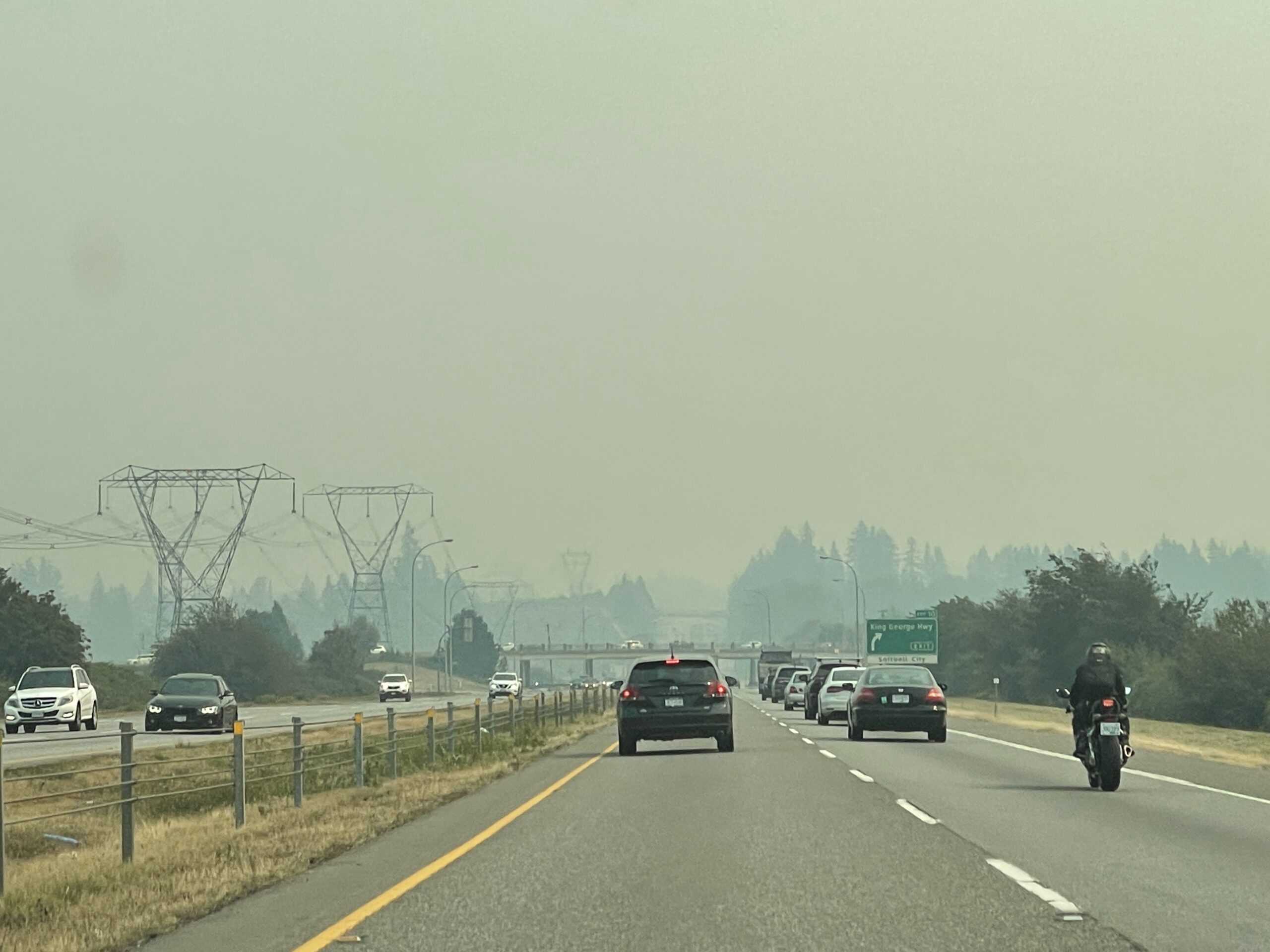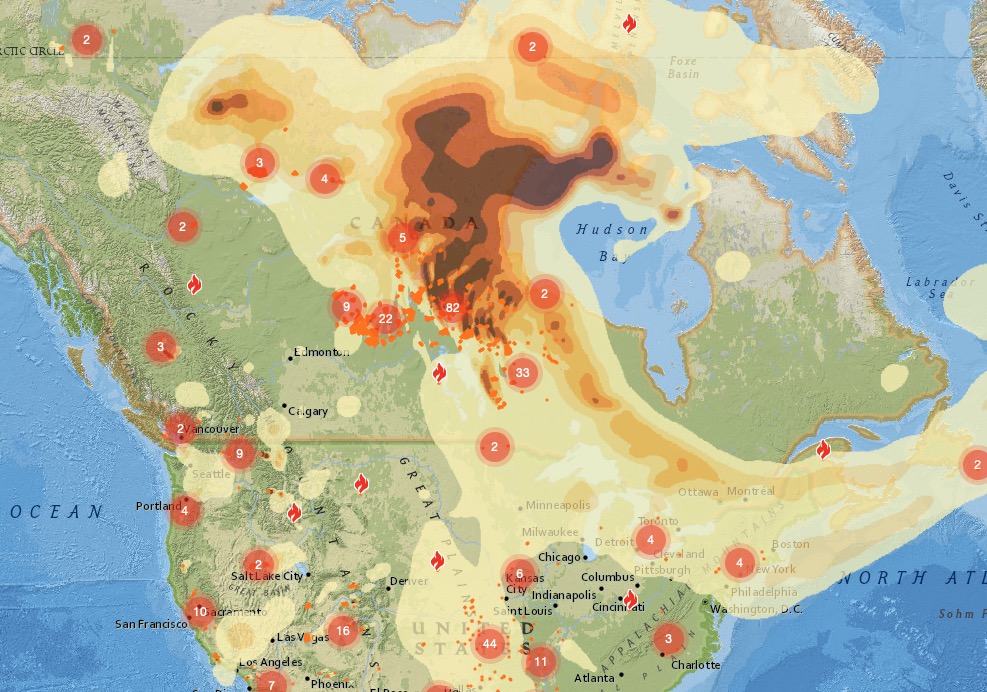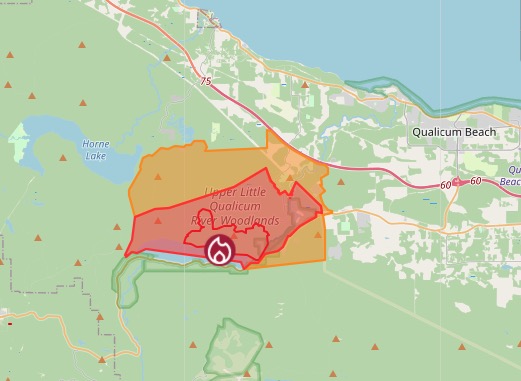US doubles countervailing duties on Canadian softwood lumber, bringing total duties to more than 35%. In response, BC and Ontario groups condemn the hike, the US Lumber Coalition says Canada’s support for lumber ‘knows no bounds’; and US Homebuilders fear duties could go much higher. Lots more news on our website—noteworthy headlines include:
- Canada’s 2025 wildfire season now second-worst on record
- Dry conditions taking a toll across New Brunswick
- Record temps, fires and floods roil weather across the USA
- Forest Service Faces Identity Crisis in USDA Overhaul Plan
 Finally, a reminder that The Tree Frog News is taking a short summer break this week. While we’ll still bring you forestry news each day, our coverage may be “lighter” — without the detailed Takeaway.
Finally, a reminder that The Tree Frog News is taking a short summer break this week. While we’ll still bring you forestry news each day, our coverage may be “lighter” — without the detailed Takeaway.
Don’t forget — our news stories are always available daily at this link: treefrogcreative.ca/news/. Bookmark it and check in anytime. We’ll be back to full strength next week. Thanks for reading, and we appreciate your support!
Kelly McCloskey, Tree Frog News Editor







 British Columbia’s forestry leaders offer a mix of praise and caution following the announcement of federal aid for Canada’s lumber industry. While both welcomed the support, they emphasized the urgent need for fiber access and resolving the US trade dispute. B.C. Forestry Minister Ravi Parmar called the federal funding package “really good news” and a long-overdue show of federal support for a sector that has long felt sidelined in Ottawa. …Parmar emphasized that B.C., as the world’s second-largest exporter of softwood lumber, must receive a proportional share of the funding to modernize its mills and build new global partnerships. …B.C. Conservative forestry critic Ward Stamer, welcomed the funding as a positive sign of federal commitment but warned that the underlying problems plaguing B.C.’s forestry industry remain unaddressed. …“It shows the federal government understands how important the forest industry is not just to B.C., but to the whole country,” said Stamer.
British Columbia’s forestry leaders offer a mix of praise and caution following the announcement of federal aid for Canada’s lumber industry. While both welcomed the support, they emphasized the urgent need for fiber access and resolving the US trade dispute. B.C. Forestry Minister Ravi Parmar called the federal funding package “really good news” and a long-overdue show of federal support for a sector that has long felt sidelined in Ottawa. …Parmar emphasized that B.C., as the world’s second-largest exporter of softwood lumber, must receive a proportional share of the funding to modernize its mills and build new global partnerships. …B.C. Conservative forestry critic Ward Stamer, welcomed the funding as a positive sign of federal commitment but warned that the underlying problems plaguing B.C.’s forestry industry remain unaddressed. …“It shows the federal government understands how important the forest industry is not just to B.C., but to the whole country,” said Stamer.
 WASHINGTON — More Republican lawmakers are calling out Canada because of wildfires sending smoke billowing across the international border into their states. Wisconsin state Rep. Calvin Callahan has joined other Republican state lawmakers from Iowa, Minnesota and North Dakota in filing a formal complaint against Canada to the U.S. Environmental Protection Agency and the International Joint Commission. In a news release issued today, Callahan says that “if Canada can’t get these wildfires under control, they need to face real consequences.” He joins a chorus of Republican politicians at other levels of government who have been voicing concerns about Canada’s wildfires. Michigan Rep. Jack Bergman sent a letter to Canadian Sen. Michael MacDonald on Monday calling for stronger forest management policies and more accountability from Canadian officials. Michigan Rep. John James sent a letter to Prime Minister Mark Carney last week saying his constituents are choking on toxic wildfire smoke.
WASHINGTON — More Republican lawmakers are calling out Canada because of wildfires sending smoke billowing across the international border into their states. Wisconsin state Rep. Calvin Callahan has joined other Republican state lawmakers from Iowa, Minnesota and North Dakota in filing a formal complaint against Canada to the U.S. Environmental Protection Agency and the International Joint Commission. In a news release issued today, Callahan says that “if Canada can’t get these wildfires under control, they need to face real consequences.” He joins a chorus of Republican politicians at other levels of government who have been voicing concerns about Canada’s wildfires. Michigan Rep. Jack Bergman sent a letter to Canadian Sen. Michael MacDonald on Monday calling for stronger forest management policies and more accountability from Canadian officials. Michigan Rep. John James sent a letter to Prime Minister Mark Carney last week saying his constituents are choking on toxic wildfire smoke.
 The Maine State Chamber of Commerce has been following the Trump administration’s actions on tariffs since the start of the year, said President and Chief Executive Officer Patrick Woodcock. …Woodcock said Monday that some individual companies and industries are already seeing a “dramatic impact.” For example, he said lumber product prices have increased. … In Maine, “our forest products industry is the one that is most affected with these specific industry, sector-level tariffs,” Woodcock said. The state imports 2.3 million tons of wood products annually, most of which comes from Canada, according to a Maine Forest Service
The Maine State Chamber of Commerce has been following the Trump administration’s actions on tariffs since the start of the year, said President and Chief Executive Officer Patrick Woodcock. …Woodcock said Monday that some individual companies and industries are already seeing a “dramatic impact.” For example, he said lumber product prices have increased. … In Maine, “our forest products industry is the one that is most affected with these specific industry, sector-level tariffs,” Woodcock said. The state imports 2.3 million tons of wood products annually, most of which comes from Canada, according to a Maine Forest Service 

 A Seattle proposal to add more housing above the historic Doyle Building near Pike Place Market is bringing out significant opposition, with nearby condominium owners seeking to utilize the only point of leverage they have: the city’s landmarks board. Clark/Barnes architects are working with the owners of the four-story building….
A Seattle proposal to add more housing above the historic Doyle Building near Pike Place Market is bringing out significant opposition, with nearby condominium owners seeking to utilize the only point of leverage they have: the city’s landmarks board. Clark/Barnes architects are working with the owners of the four-story building…. 
 Growing up in the Greater Toronto Area, smog days were par for the course. …We’ve traded our smog days for smoke days. …Improving wildfire response should be an imperative of Prime Minister Mark Carney and his newly formed government. …Wildfires will burn no matter how many waterbombers Canada has, but there is no question there would be fewer homes destroyed, less First Nations forced to evacuate and fewer air quality alerts issued if Saskatchewan had 600 aircraft in action right now, rather than six. …Let’s turn this whole country into a waterbomber assembly line. The demand isn’t going anywhere — domestically or internationally. …In the meantime, the federal government needs to ramp up funding transfers to the provinces for wildfire fighter and pilot training programs and equipment purchases. …Getting forest fires under control is also an act of sovereignty.
Growing up in the Greater Toronto Area, smog days were par for the course. …We’ve traded our smog days for smoke days. …Improving wildfire response should be an imperative of Prime Minister Mark Carney and his newly formed government. …Wildfires will burn no matter how many waterbombers Canada has, but there is no question there would be fewer homes destroyed, less First Nations forced to evacuate and fewer air quality alerts issued if Saskatchewan had 600 aircraft in action right now, rather than six. …Let’s turn this whole country into a waterbomber assembly line. The demand isn’t going anywhere — domestically or internationally. …In the meantime, the federal government needs to ramp up funding transfers to the provinces for wildfire fighter and pilot training programs and equipment purchases. …Getting forest fires under control is also an act of sovereignty.  The Forest Stewardship Council Canada announces the launch of a public consultation on draft indicators related to Intact Forest Landscapes (IFLs). These indicators form part of our ongoing work to strengthen forest stewardship and protect ecologically and culturally significant forest areas across Canada. IFLs are large, unfragmented areas of natural forest that are free from significant human activity and are critical for biodiversity, carbon storage, and Indigenous cultural values. FSC Canada is committed to ensuring that management activities in IFLs are carefully assessed and responsibly planned. These indicators will guide how FSC-certified forest operations manage intact forest areas… Indigenous Cultural Landscapes (ICLs) are areas that hold significant cultural, ecological, and spiritual value to Indigenous Peoples, reflecting their deep relationships with the land. Due to the need for more in-depth consultation with Indigenous Peoples on the Draft Indicators and Guidance for ICLs, an additional consultation period will be launched shortly.
The Forest Stewardship Council Canada announces the launch of a public consultation on draft indicators related to Intact Forest Landscapes (IFLs). These indicators form part of our ongoing work to strengthen forest stewardship and protect ecologically and culturally significant forest areas across Canada. IFLs are large, unfragmented areas of natural forest that are free from significant human activity and are critical for biodiversity, carbon storage, and Indigenous cultural values. FSC Canada is committed to ensuring that management activities in IFLs are carefully assessed and responsibly planned. These indicators will guide how FSC-certified forest operations manage intact forest areas… Indigenous Cultural Landscapes (ICLs) are areas that hold significant cultural, ecological, and spiritual value to Indigenous Peoples, reflecting their deep relationships with the land. Due to the need for more in-depth consultation with Indigenous Peoples on the Draft Indicators and Guidance for ICLs, an additional consultation period will be launched shortly. 



 In May, the White House Office of Budget and Management sent Congress President Trump’s proposed budget for discretionary spending for upcoming fiscal year 2026. Among the budget’s many cuts is a proposal to eliminate all funding for the Collaborative Forest Landscape Restoration Program, designed to make timber projects run more smoothly. The Collaborative is a decades-long experiment to get conservationists, the timber industry and U.S. Forest Service back to the proverbial table after the timber wars of years past. Collaboratives have been widely credited with incorporating conservationist’s environmental concerns in the design of timber harvests and, consequently, reducing environmental litigation known to slow down harvests. The CFLRP has been lauded by some for helping implement forest thinning and restoration projects meant to both reduce wildfire risk and increase timber production and jobs in rural communities.
In May, the White House Office of Budget and Management sent Congress President Trump’s proposed budget for discretionary spending for upcoming fiscal year 2026. Among the budget’s many cuts is a proposal to eliminate all funding for the Collaborative Forest Landscape Restoration Program, designed to make timber projects run more smoothly. The Collaborative is a decades-long experiment to get conservationists, the timber industry and U.S. Forest Service back to the proverbial table after the timber wars of years past. Collaboratives have been widely credited with incorporating conservationist’s environmental concerns in the design of timber harvests and, consequently, reducing environmental litigation known to slow down harvests. The CFLRP has been lauded by some for helping implement forest thinning and restoration projects meant to both reduce wildfire risk and increase timber production and jobs in rural communities.
 Toronto is among the most polluted cities in the world on Monday morning as the city remains under a special air quality statement for its third consecutive day. Environment Canada said smoke from forest fires is expected to continue to impact much of southern Ontario Monday and may persist into Tuesday before finally easing. “Air quality and visibility due to wildfire smoke can fluctuate over short distances and can vary considerably from hour to hour,” said Environment Canada in a special air quality statement issued Monday morning. …Toronto ranked third in a
Toronto is among the most polluted cities in the world on Monday morning as the city remains under a special air quality statement for its third consecutive day. Environment Canada said smoke from forest fires is expected to continue to impact much of southern Ontario Monday and may persist into Tuesday before finally easing. “Air quality and visibility due to wildfire smoke can fluctuate over short distances and can vary considerably from hour to hour,” said Environment Canada in a special air quality statement issued Monday morning. …Toronto ranked third in a  FREMONT, Neb. — The U.S. Chemical Safety and Hazard Investigation Board (CSB) has opened a formal investigation into the July 29 explosion and fire at the Horizon Biofuels facility in Fremont that killed three people, officials announced Thursday. The blast fatally injured 32-year-old Dylan Danielson and his two young daughters who were inside the plant at the time. “This horrific incident should never have happened,” CSB Chairperson Steve Owens said in a statement. “We want to prevent a terrible tragedy like this from occurring again.” …The independent federal agency, whose members are appointed by the president and confirmed by the Senate, does not issue citations or fines but makes safety recommendations to companies, industry groups, labor organizations and agencies such as OSHA and the Environmental Protection Agency.
FREMONT, Neb. — The U.S. Chemical Safety and Hazard Investigation Board (CSB) has opened a formal investigation into the July 29 explosion and fire at the Horizon Biofuels facility in Fremont that killed three people, officials announced Thursday. The blast fatally injured 32-year-old Dylan Danielson and his two young daughters who were inside the plant at the time. “This horrific incident should never have happened,” CSB Chairperson Steve Owens said in a statement. “We want to prevent a terrible tragedy like this from occurring again.” …The independent federal agency, whose members are appointed by the president and confirmed by the Senate, does not issue citations or fines but makes safety recommendations to companies, industry groups, labor organizations and agencies such as OSHA and the Environmental Protection Agency. Dust collection expert Robert Williamson at Nederman Corporation, commented on a video of the deadly explosions at Horizon Biofuels, in Fremont, Nebraska. “It’s only speculation at this point, but it is these types of [wood dust explosive] events where we see fatalities,” said Williamson, VP Technical Solutions and Business Development North America. “You have the primary explosion and then a bigger explosion, the whole elevator explodes, and part of the building.” After the primary event, fine dust, which is more reactive than heavier dust and tends to accumulate in hard-to-clean areas, causes a secondary explosion, which experts on the scene also believe was the case in this instance. …Wood dust explosions can happen so fast that there is no time to evacuate. “These things happen so quickly, in less than 500 milliseconds,” he said, “There’s really no way to get away. Nobody’s going to run from this.”
Dust collection expert Robert Williamson at Nederman Corporation, commented on a video of the deadly explosions at Horizon Biofuels, in Fremont, Nebraska. “It’s only speculation at this point, but it is these types of [wood dust explosive] events where we see fatalities,” said Williamson, VP Technical Solutions and Business Development North America. “You have the primary explosion and then a bigger explosion, the whole elevator explodes, and part of the building.” After the primary event, fine dust, which is more reactive than heavier dust and tends to accumulate in hard-to-clean areas, causes a secondary explosion, which experts on the scene also believe was the case in this instance. …Wood dust explosions can happen so fast that there is no time to evacuate. “These things happen so quickly, in less than 500 milliseconds,” he said, “There’s really no way to get away. Nobody’s going to run from this.” Rapidly growing wildfires in several provinces forced thousands of people from their homes and prompted air-quality warnings in cities thousands of kilometres away, while hot and dry conditions had other areas on high alert, including Nova Scotia, where the government banned most summertime activities in wooded areas. The deteriorating conditions have added up to a wildfire season that is on track to be one of Canada’s worst on record in terms of area burned, second only to 2023. As of Tuesday, at least 15,000 people were under evacuation orders in Manitoba, largely in the province’s north, while fires on Newfoundland and Labrador’s Avalon Peninsula had forced around 600 people from their homes. Across the country, more than 760 wildfires are burning, at least 205 of them deemed out of control. About 6.8 million hectares of land have burned so far this year.
Rapidly growing wildfires in several provinces forced thousands of people from their homes and prompted air-quality warnings in cities thousands of kilometres away, while hot and dry conditions had other areas on high alert, including Nova Scotia, where the government banned most summertime activities in wooded areas. The deteriorating conditions have added up to a wildfire season that is on track to be one of Canada’s worst on record in terms of area burned, second only to 2023. As of Tuesday, at least 15,000 people were under evacuation orders in Manitoba, largely in the province’s north, while fires on Newfoundland and Labrador’s Avalon Peninsula had forced around 600 people from their homes. Across the country, more than 760 wildfires are burning, at least 205 of them deemed out of control. About 6.8 million hectares of land have burned so far this year.

 A wildfire on Vancouver Island is threatening Douglas-fir trees in Cathedral Grove, located on the western shoreline of Cameron Lake. The old-growth forest is filled with gigantic 800-year-old trees… The out-of-control Wesley Ridge wildfire was discovered on July 31 and is now 511 hectares in size. The Regional District of Nanaimo issued an evacuation order on August 2, which affected nearly 400 properties in the area around Cameron Lake, about 25 kilometres west of Parksville. …The fire has grown rapidly over the weekend as it looms over Highway 4, which remains open for the time being. Crews are trying to push it back, even using night vision so they can battle the blaze 24 hours a day. Emelie Peacock with the BC Wildfire service says, “we currently have 142 personnel responding to this wildfire, which includes 65 firefighters, 2 followers, and roughly 75 structure protection specialists”. …The fire is suspected to be human-caused … investigation is still in its preliminary stages.
A wildfire on Vancouver Island is threatening Douglas-fir trees in Cathedral Grove, located on the western shoreline of Cameron Lake. The old-growth forest is filled with gigantic 800-year-old trees… The out-of-control Wesley Ridge wildfire was discovered on July 31 and is now 511 hectares in size. The Regional District of Nanaimo issued an evacuation order on August 2, which affected nearly 400 properties in the area around Cameron Lake, about 25 kilometres west of Parksville. …The fire has grown rapidly over the weekend as it looms over Highway 4, which remains open for the time being. Crews are trying to push it back, even using night vision so they can battle the blaze 24 hours a day. Emelie Peacock with the BC Wildfire service says, “we currently have 142 personnel responding to this wildfire, which includes 65 firefighters, 2 followers, and roughly 75 structure protection specialists”. …The fire is suspected to be human-caused … investigation is still in its preliminary stages.

 Arizona’s fire season keeps smoldering and flaring, thanks to a schizo monsoon and a dry winter. The 125,000-acre Dragon Bravo Fire continues to grow, with the 1,200 firefighters managing just 13% containment after nearly a month of trying. The National Weather Service had predicted a normal to wet monsoon after a bone-dry winter, based largely on sea-surface temperatures in the Pacific. But as a global warming trend driven by heat-trapping pollutants pumps energy into the atmosphere, patterns of drought, heat and storm tracks have become harder and harder to predict. So the monsoon has splashed and sputtered, with a week of storms giving way to a week of hot, dry weather – extending the fire season well into the period when fire crews would normally shift to other areas. Fortunately, the extended forecast calls for a chance the monsoon will gust back to life next week.
Arizona’s fire season keeps smoldering and flaring, thanks to a schizo monsoon and a dry winter. The 125,000-acre Dragon Bravo Fire continues to grow, with the 1,200 firefighters managing just 13% containment after nearly a month of trying. The National Weather Service had predicted a normal to wet monsoon after a bone-dry winter, based largely on sea-surface temperatures in the Pacific. But as a global warming trend driven by heat-trapping pollutants pumps energy into the atmosphere, patterns of drought, heat and storm tracks have become harder and harder to predict. So the monsoon has splashed and sputtered, with a week of storms giving way to a week of hot, dry weather – extending the fire season well into the period when fire crews would normally shift to other areas. Fortunately, the extended forecast calls for a chance the monsoon will gust back to life next week. France’s biggest wildfire this summer was spreading quickly Wednesday in a Mediterranean region near the Spanish border after leaving one person dead, authorities said. The fire had burned an area larger than Paris. About 2,000 firefighters and several water bomber aircraft battled the blaze that broke out Tuesday afternoon in the village of Ribaute in the Aude region, a rural, wooded area that is home to wineries. The fire, which has burned 13,000 hectares (32,000 acres), remained ‘’very active” on Wednesday, the local administration said in a statement. The weather was hot, dry and windy, making it difficult for firefighters to contain the blaze. One person died in their home, and at least 13 others were injured, including 11 firefighters, local authorities said. One person who was initially described as missing has been located and is safe.
France’s biggest wildfire this summer was spreading quickly Wednesday in a Mediterranean region near the Spanish border after leaving one person dead, authorities said. The fire had burned an area larger than Paris. About 2,000 firefighters and several water bomber aircraft battled the blaze that broke out Tuesday afternoon in the village of Ribaute in the Aude region, a rural, wooded area that is home to wineries. The fire, which has burned 13,000 hectares (32,000 acres), remained ‘’very active” on Wednesday, the local administration said in a statement. The weather was hot, dry and windy, making it difficult for firefighters to contain the blaze. One person died in their home, and at least 13 others were injured, including 11 firefighters, local authorities said. One person who was initially described as missing has been located and is safe.